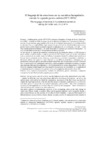Mostrar o rexistro simple do ítem
El lenguaje de las emociones en las narrativas humanitarias durante la segunda guerra carlista (1872-1876)
| dc.contributor.author | Arrizabalaga, Jon | |
| dc.date.accessioned | 2020-03-03T09:39:12Z | |
| dc.date.available | 2020-03-03T09:39:12Z | |
| dc.date.issued | 2019 | |
| dc.identifier.citation | Arrizabalaga, J. (2019). El lenguaje de las emociones en las narrativas humanitarias durante la segunda guerra carlista (1872-1876). Revista de Lexicografía, 25, pp. 115-129. DOI: https://doi.org/10.17979/rlex.2019.25.0.5990 | es_ES |
| dc.identifier.issn | 1134-4539 | |
| dc.identifier.uri | http://hdl.handle.net/2183/25086 | |
| dc.description.abstract | [Resumen] La última guerra carlista (1872-1876) constituyó el bautismo de fuego de la Cruz Roja Española (CRE) —fundada en 1864, el mismo año de la adhesión de España a la Convención de Ginebra— así como el más temprano gran conflicto civil al que el movimiento internacional de Cruz Roja se hubo de enfrentar. Pese a la imposibilidad legal entonces de que el Comité de Ginebra pudiera intervenir en guerras civiles, ambos bandos acordaron respetar los principios de la Convención, y la CRE —como otras organizaciones humanitarias, y de modo destacado La Caridad, que crearon los insurgentes— se volcó en actividades de socorro a los combatientes heridos y enfermos. En este artículo se exploran las narrativas humanitarias de dos destacados líderes de CRE durante la guerra carlista: el oficial médico e inspector general de CRE Nicasio Landa y la jurista, reformadora social y secretaria de su comité central de Señoras, Concepción Arenal. Se analizan estas narrativas en diversas fuentes primarias (cartas, informes, relatos literarios, artículos), destacándose similitudes y diferencias mutuas con respecto a cuatro aspectos: (i) sus públicos, propósitos y estrategias; (ii) sus apreciaciones acerca de quiénes merecían la ayuda humanitaria; (iii) sus preocupaciones por el bienestar físico y emocional de los combatientes enfermos y heridos atendidos en distintos escenarios y transportados mediante diferentes procedimientos; y (iv) la identidad de los actores humanitarios. Todo ello al objeto de examinar el papel jugado por estas narrativas humanitarias en el modelado de la compasión de la ciudadanía hacia las víctimas en las guerras civiles y el consiguiente afianzamiento de la CRE. | es_ES |
| dc.description.abstract | [Abstract]The last Carlist war (1872-1876) was the baptism of fire of the Spanish Red Cross (SRC) —founded in 1864, the very year when Spain adhered to the Geneva Convention— as well as the earliest major civil conflict in which the international movement of the Red Cross was involved. Despite the legal impossibility at the time that the Geneva Committee could intervene in civil wars, both sides agreed to respect the Convention’s principles, and the SRC —like other humanitarian associations, and singularly La Caridad, that was created by the insurgents— threw themselves in relief activities to the wounded and sick combatants. This article explores the humanitarian narratives of two outstanding leaders of the SRC during the Carlist war: Nicasio Landa, a medical officer and its general inspector, and Concepción Arenal, a jurist, social reformer and the secretary of its Ladies Central Committee. It analyses their narratives in different primary sources (letters, reports, literary accounts, articles) by paying particular attention to their similitudes and differences each other with regard to four aspects: (i) their publics, purposes and strategies; (ii) their appreciations as to who deserved humanitarian aid; (iii) their concerns about the physic and emotional wellbeing of the sick and wounded combatants being looked after in varied spaces and transported by means of different procedures; and (iv) the identity of humanitarian actors. All this with the object of examining the role played by these humanitarian narratives in modelling citizen’s compassion towards the victims in civil wars, and the strengthening of the SRC | es_ES |
| dc.description.sponsorship | Ministerio de Economía y Competitividad; HAR2015-67723-P | es_ES |
| dc.language.iso | spa | es_ES |
| dc.publisher | Universidade da Coruña | es_ES |
| dc.relation.uri | https://doi.org/10.17979/rlex.2019.25.0.5990 | es_ES |
| dc.rights | Atribución-NoComercial-CompartirIgual 4.0 España | es_ES |
| dc.rights.uri | http://creativecommons.org/licenses/by-nc-sa/3.0/es/ | * |
| dc.subject | Narrativas humanitarias | es_ES |
| dc.subject | Cuidados de enfermería | es_ES |
| dc.subject | Género | es_ES |
| dc.subject | Emociones | es_ES |
| dc.subject | Compasión | es_ES |
| dc.subject | Concepción Arenal | es_ES |
| dc.subject | Nicasio Landa | es_ES |
| dc.subject | Segunda guerra carlista | es_ES |
| dc.subject | Humanitarian narrative | es_ES |
| dc.subject | Nursing care | es_ES |
| dc.subject | Gender | es_ES |
| dc.subject | Emotions | es_ES |
| dc.subject | Compassion | es_ES |
| dc.subject | Carlist war | es_ES |
| dc.title | El lenguaje de las emociones en las narrativas humanitarias durante la segunda guerra carlista (1872-1876) | es_ES |
| dc.title.alternative | The language of emotions in humanitarian narratives during the Carlist war, 1872-1876 | es_ES |
| dc.type | info:eu-repo/semantics/article | es_ES |
| dc.rights.access | info:eu-repo/semantics/openAccess | es_ES |
| UDC.journalTitle | Revista de Lexicografía | es_ES |
| UDC.volume | 25 | es_ES |
| UDC.startPage | 115 | es_ES |
| UDC.endPage | 129 | es_ES |






